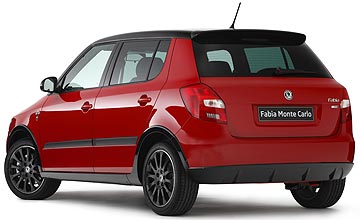BY MIKE COSTELLO | 21st Sep 2011

Considering it shares many components with the class-leading Volkswagen Polo, the littlest car from the Czech manufacturer lobs here with some pretty great expectations on its square-shaped shoulders.
It is this boxiness of design that is first noticed when approaching the car. It follows the lead of its bigger Ocatvia brother in this regard and also bears a bit of a resemblance to the similarly chunky Suzuki Swift.
The large choice of colours and the optional contrasting white or silver roof paint finish – a la the Mini – help to give the car a spunky character missing from its more demure Polo sister.
The sporting Monte Carlo variant takes this even further, featuring menacing black wheel arches filled with attractive 16-inch alloy wheels, a black grille and – you guessed it – black foglight surrounds and roof finish.
The well-bolstered sports seats with optional red highlights and the sports steering wheel are nice touches too, although the fact that the latter misses out on the base model’s audio and phone controls is disappointing.
Once sitting inside the car though, it becomes immediately apparent that this is a car made to a price. Contact points on the doors and instrument fascia lack the tactility of the Polo or Fiesta, with the cheap-feeling steering wheel on the base variant and flimsy interior door handles the worst culprits.
Despite this, the airy cabin is still a pretty pleasant place to be, with comfortable (if a little narrow) seats, a clear and logical instrument display and acres of head- and leg-room in the front and back, catering adequately for your 195cm tall correspondent.
Thank the boxy shape and relatively low window-line for this, showing styling need not come at the cost of claustrophobic back seats: Rivals, take note.
Luggage space is nothing short of excellent, with the wide and deep boot accommodating 315 litres with the seats up and 1180 litres when the 60:40-split folding rear pews are down.
We drove the Fabia through a variety of conditions in order to get a proper grasp of the little car’s dynamic capabilities, and came away reasonably impressed.
Taking in the bustling streets of inner-Sydney, the flowing freeways of the outer suburbs and the twisty tarmac that cuts along the forests of the coastline to the south of the city revealed the Fabia to be a fun and eager little machine, though one with a couple of weak points.
The familiar characterful eagerness of the titchy 1.2-litre engine is the first thing we noticed. The little mill continues to punch well above its weight division thanks to the Volkswagen Group’s mastery of turbo technology.
The healthy dose of torque (175Nm to be exact) is readily available across a wide range of the rev band, while the five-speed manual gearbox pairs a pleasant and notch-free feel with a light clutch.
We might be biased, but the manual also eliminates the low-end fussiness and lag that hampers the engine when it is matched to the seven-speed DSG gearbox in the Polo (and will join the Fabia range early next year).
That said, the gearbox was crying out for a sixth ratio during highway cruising, with the tachometer sitting just shy of 3000rpm at 110km/h. Despite this, the well-insulated cabin kept noise and vibration down to a respectable level.
While the car did exhibit some bodyroll at the limits, this is unlikely to be of much concern to the average Fabia driver, and the relatively direct electro-hydraulic steering is quick and reassuring with plenty of feel.
Same goes for the all-round disc brakes too, which have decent bite and reassuring effectiveness. The at-times jarring road surfaces of the Harbour City also failed to unnerve the little car’s composure, with the ride quality never dropping below a high standard.
Real-world fuel consumption was pretty impressive as well. We pushed the little Czech pretty hard over a distance just shy of 300km across a wide range of conditions, and the gauge was still reading a tick over half-full upon our return.
We have little reason to doubt the official claimed consumption of 5.5 litres per 100km over the combined cycle could be easily achieved with more careful driving.
All in all, the Fabia is not quite on a par with the Polo or Fiesta for sheer drivability, giving less surety at the outer limits and showing less refinement at cruising speed with the absence of a sixth gear ratio, but it would still make a fun and zippy day-to-day companion.
Throw in a nice dash of Euro charm and a very tempting price and here we have a car that – despite already being four years old – still has a lot to offer.
Once the DSG, wagon and RS models are launched – and more importantly, if Skoda can avoid the supply issues that have troubled it in the past – we think they should have a hit on their hands.
It may not quite be a match for the segment-leading Fiesta and Polo, but it does offer unique styling, lots of equipment and a very tempting price. On top of this, the resale value of Skodas have historically fared well in the Australian market.
Our advice? Grab a 77TSI with the optional contrasting white or silver roof finish and optional 15-inch alloy wheels (grand total $20,370 plus on-roads) and you have a unique and interesting little car that makes a point of difference from the standard crowd in the segment.
Or, better yet, nab the slightly pricier Monte Carlo from $21,990. The black exterior highlights and excellent sports seats and steering wheel combination (despite the sad lack of buttons) make it an enticing prospect indeed.